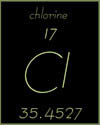
![]()

![]()
 Name: Chlorine
Name: Chlorine
Symbol: Cl
Atomic Number:17
Atomic Weight: 35.4527g
![]()
Chlorine is a yellowish-green gas at standard temperature and pressure. It is extremely reactive with most elements. Because its density is greater than that of air, the gas settles low to the ground. It is a respiratory irritant, and it burns the skin. Just a few breaths of it are fatal. Cl2 gas does not occur naturally, although Chlorine can be found in a number of compounds.
![]()
Standard State: gas at 298K
Melting Point: 171.6K (-101.5 C)
Boiling Point: 239.11K (-34.04 C)
Density: N/A
Molar Volume: 17.39 cm3
Electronegativity: 3.16 Pauling Units
Crystal Structure: The Diatomic Chlorine molecules arrange themselves in an orthohombic structure.

Model of Chlorine crystal structure.
![]()
Chlorine is a halogen gas. It is almost always found in the -1 oxidation state. This is because it has a strong tendency to gain an electron and achieve a noble gas electron configuration.
![]()
| Isotope | molar mass | abundance |
| 35Cl | 34.9689g | 75.78% |
| 37Cl | 36.9559g | 24.22% |
![]()
The electron configuration of Chlorine is [Ne]3s23p5

Note that Chlorine only needs one electron to achieve the electron configuration of Argon.
![]()
Chlorine occurs naturally in ionic solids like NaCl and KCl. Large quantities of NaCl are dissolved in the world's oceans. NaCl crystals, called Halites (Rock Salt) can be found in nature. Below are pictured several Halite crystals which have been tinted by impurities or microorganisms.


I encountered a large quantity of Halites
on my recent trip to Death Valley.
Halite crystals are crunchy when you walk
on them. It is very entertaining.
Chlorine gas is produced in industry from brine (NaCl dissolved in water) using electrolysis.
It can also be produced in several other ways such as reacting hydrochloric acid and manganese dioxide.

A plant for chlorine production.
The going price for chlorine is apparently classified information which cannot be divulged to simple college students like me. Most of the main producers of chlorine gas use the ominous terms "contact us for an estimate" when referring to their product. I have no intention to purchase large quantities of chlorine gas in the near future, and I am not sure how seriously they would take an offer from me anyway.
![]()
There are a number of very important uses for chlorine in today's society.
Chlorine is used in the production of paper, cleaners and solvents, plastics, paints, insecticides, textiles, and petroleum products among other things. Chlorine is used in the production of 85% of the medicines we use today.
Chlorine is used to extract bromine.
Chlorine is used to disinfect swimming pools and hot tubs. Chlorine bleach is used as a very effective cleaning agent.
Chlorine is used in the production of PVCs, or polyvinyl chlorides.
Most importantly, chlorine is used to sanitize the world's drinking water.
Chlorine production and use is a controversial issue because of the many adverse effects chlorine production and use can have on the environment and on human health. CFC's, or chlorofluorocarbons, contribute to the destruction of the ozone layer when released into the atmosphere.
![]()
Chlorine gas was discovered in 1774 by Carl Wilhelm Scheele when he reacted manganese dioxide with hydrochloric acid. He believed it to be a gas containing oxygen.
Sir Humphrey Davy showed that Chlorine was an element in 1810, and named it from the Greek word for pale green.
Chlorine gas was used in World War I because of its devastating effects on human beings.
![]()
For this website I made use of Zumdahl's Chemical Principles, as well as numerous websites. The "Chlorine Knowledge Center" gave me information about the chlorine industry. Information on naturally occurring minerals containing chlorine can be found at Webmineral. Also notable was the chlorine section of WebElements, an amazing site where one can find practically everything they ever wanted to know about an element.
The crystal structure picture was borrowed from WebElements. The chlorine plant picture and the ice cream man picture were borrowed from random websites. All other graphics were created by me.
![]()


this man understands the beauty of ice cream. Chlorine in rock salt is extremely important for the production of ice cream.
![]()
page by:
Pomona College
Chemistry 1B